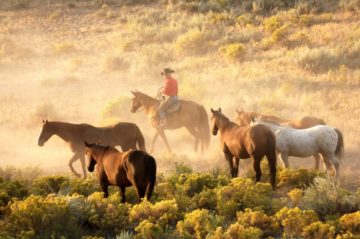 In this issue of the Eponaquest News, Linda Kohanov answers some thought-provoking questions about her new book The Five Roles of a Master Herder: A Revolutionary Model for Socially Intelligent Leadership. Learn how and why balancing all five roles will enhance your relationships and your effectiveness at work, home, school, the barn, and beyond.
In this issue of the Eponaquest News, Linda Kohanov answers some thought-provoking questions about her new book The Five Roles of a Master Herder: A Revolutionary Model for Socially Intelligent Leadership. Learn how and why balancing all five roles will enhance your relationships and your effectiveness at work, home, school, the barn, and beyond.
Learning to share power in a balanced way can be a great challenge, especially to long-established businesses and companies that are enmeshed in old ways of doing things. Why is this transformation to empowerment, innovation and adaptation so important?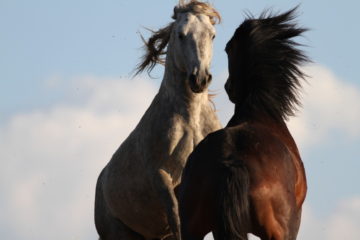
We live in an era of rapid change and unprecedented freedom. We need creative, empowered people to adjust to constantly changing markets, and capitalize on innovations that are emerging at breakneck speed. Conflicts and power struggles between professionals are common—and, as I discovered in researching animal and human behavior, instinctual. But these often-unconscious power plays waste incredible amounts of time and money. The freedom we now have requires that people develop sophisticated, socially intelligent leadership skills to excel, not only in corporations and small businesses, but also in social service, educational, religious, familial, community-based, and political settings.
Research shows that aggressive or inept managers are particularly destructive to the bottom line in all kinds of business settings. A Gallup poll of more than a million US workers showed that the Number 1 reason people quit their jobs is a bad boss or immediate supervisor. Gallup also determined that poorly managed workers are 50 percent less productive and 44 percent less profitable than well-managed groups.
High employee turnover is a huge expense, of course, but the implications have become even more serious in the last 20 years. If you alienate intelligent and talented employees, the ones who can really help your company shine, they might do something more infuriating than just quit, they might become your competition. In the 21st century, anyone with a great idea can raise money online, order supplies delivered to the door, and conceive a multi-million dollar corporation in the 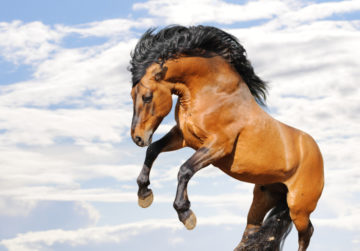 corner of a basement or a garage.
corner of a basement or a garage.
A balanced use of the Five Roles is also essential in working with challenging horses, and in forming stronger partnerships with all kinds of social animals. In fact, as I describe in the book, I initially learned these skills working with herds of proud, sensitive, and intelligent Arabian horses who—like free, empowered people—rebel against traditional command-control training techniques. As I employed these principles to gain the cooperation of aggressive stallions in particular, my relationships at home and at work improved almost miraculously, and I saw the benefits of using the Five Roles in purely human contexts.
Over the years, I developed safe ground activities with gentler horses that allowed me to teach these same skills to people with no equestrian  experience, and the results have been impressive. Since 2007, in fact, we’ve successfully used a combination of horse-facilitated activities and indoor, on-site seminars to train leaders at one of the major players in the aerospace industry (among other types of corporate, small business, and community/social service organizations). The missile-building entity in particular currently wishes to remain anonymous because they consider us one of their “secret weapons” in gaining a market edge. Developing horse-facilitated trainings for engineers isn’t rocket science, but it does have a profound effect on rocket scientists, as it turns out.
experience, and the results have been impressive. Since 2007, in fact, we’ve successfully used a combination of horse-facilitated activities and indoor, on-site seminars to train leaders at one of the major players in the aerospace industry (among other types of corporate, small business, and community/social service organizations). The missile-building entity in particular currently wishes to remain anonymous because they consider us one of their “secret weapons” in gaining a market edge. Developing horse-facilitated trainings for engineers isn’t rocket science, but it does have a profound effect on rocket scientists, as it turns out.
In your new book, THE FIVE ROLES OF A MASTER HERDER, you address the changing role of leadership in our culture. How is your new approach to leadership rooted in the nonverbal leadership skills of ancient herding cultures?

In researching the history of leadership in multiple cultures, I found that for thousands of years, “master herders” in nomadic pastoral cultures had developed a multi-faceted, socially intelligent form of leadership combining the roles of Dominant, Leader, Nurturer/Companion, Sentinel, and Predator into a fluid vocabulary of interventions that allowed interspecies communities to move across vast landscapes. These people had to deal with predators and changing climates, protecting and nurturing the herd while keeping these massive, gregarious, sometimes aggressive animals together—without the benefit of fences and with very little reliance on restraints.
Modern civilization, on the other hand, is based on a hierarchical, command-control model of leadership that is fast becoming problematic, simply because people are more empowered, better educated, more informed, and more mobile. Through five thousand years of conquest, slavery—and, in our time, the efforts of a privileged few to control large populations for profit and convenience—we’ve limited our own development of optimal social behavior. During the U.S. Revolutionary War, our forefathers successfully fought for freedom, but we still don’t have the skills to use it effectively. Events of the past two-hundred-and-fifty years prove that once the old fences fall down and the herd breaks free, command-control approaches become impotent. The fact that we keep using these outmoded tools, despite their compromised effectiveness, underlines our current state of arrested development. We are free, and yet we are continually sliding back into old habits, struggling to find a way out of chaos into connection.
How do these growing pains manifest in modern life?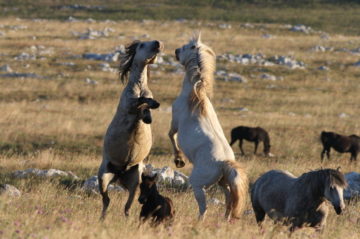
Like those feral horses we call mustangs, the descendants of human “refugees” from all walks of life — escaped slaves, liberated women, religious and political dissidents, disenfranchised youth, anarchists, peace activists, disgruntled corporate employees — can’t help but gather in groups, kicking, rearing, biting, and striving to reclaim their dignity in the outback of human experience. Until somehow, hopefully, people learn new ways to get along, to graze peacefully, protect each other, raise families, brave the elements, and endure the droughts, while seeking those mythical greener pastures. The problem is that even the most sincere, potentially innovative groups have trouble collaborating, using their power effectively, and, most importantly, airing differences constructively and respectfully. And so the same cycle of rebellion, conviction, optimism, conflict, blame, hostility, disempowerment, and disillusionment starts up again in whatever “new world” the next round of rogues and visionaries hopes to mold into the perfect “earthly paradise.” We see this cycle currently wreaking havoc in our social and political systems every time we  turn on the news.
turn on the news.
Learning to share power is the challenge of the 21st century. But we don’t have to reinvent the wheel, as it turns out. If we adopt the social intelligence and leadership skills pioneered by our nomadic cousins, while still valuing the technological innovations that could only have been perfected in a sedentary context, we will combine best of both worlds. Balancing the Five Roles of a Master Herder can help modern tribes of empowered, mobile, innovative, and adaptable people to support each other through the inevitable droughts and doubts of life as we move ever more faithfully and confidently toward the greener pastures of humanity’s own untapped potential.
Tell us more about the five roles and why we need to balance them all.
In our culture, few people—even accomplished equestrians—realize that in herds of freely roaming herbivores like horses and cattle, the Leader and the Dominant animals are often two different individuals, that they perform specific functions essential to the group’s well being, and that the other roles I mentioned also contribute to the healthy functioning of the social system—even when humans are not involved.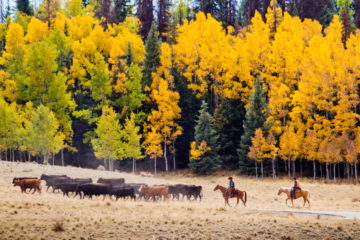
Still, most animals, homo sapiens included, are drawn toward a couple of roles, while ignoring, avoiding, or outright rejecting the others. This tendency not only keeps everyone in a state of arrested development, it has a tendency to wreak havoc in challenging situations—unless the herd or tribe is managed by an exceptional leader who, like a Master Herder in a traditional pastoral culture, is capable of employing the various roles as tools, rather than identifying with one or two.
The simple, eternally irritating truth of the matter is that each role has a shadow side that results in dysfunctional behavior when it is overemphasized. We’re well aware, for instance, that people who cling to the role of Dominant or the role of Predator can become highly destructive in businesses, in families, and most certainly in politics. Your average dictator takes it one step further, combining the roles of Dominant and Predator, enslaving and victimizing people in order to thrive at their expense. But many people don’t realize that these two roles are useful, necessary in fact, when separated and employed sparingly, for very specific purposes, by people who know when and how to employ all 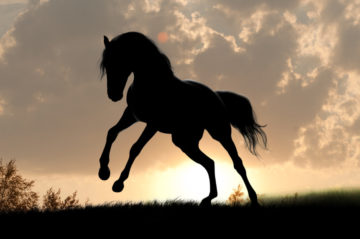 five roles for the good of the tribe. For many people, it’s counterintuitive, yet ultimately enlightening, to realize that even the Nurturer/Companion role can have toxic effects in organizations and families when this function is over-emphasized in an individual. (See answer to question 6 for more detail.) In our overspecialized world, many of us have also lost contact with the importance of the Sentinel role, not only in observing and alerting others to possible dangers on the horizon—including in our case, market shifts—but also in scanning for unexpected opportunities that help the herd and tribe thrive.
five roles for the good of the tribe. For many people, it’s counterintuitive, yet ultimately enlightening, to realize that even the Nurturer/Companion role can have toxic effects in organizations and families when this function is over-emphasized in an individual. (See answer to question 6 for more detail.) In our overspecialized world, many of us have also lost contact with the importance of the Sentinel role, not only in observing and alerting others to possible dangers on the horizon—including in our case, market shifts—but also in scanning for unexpected opportunities that help the herd and tribe thrive.
How do we recognize which of the five leadership roles we may be overemphasizing and which roles we’re avoiding?
For this book, I worked with Juli Lynch, PhD, to create the Master Herder Professional Assessment to help people measure which roles they are proficient or naturally talented in, as well as which roles they are overemphasizing or avoiding. We also wanted to measure roles that people are balancing well. Unlike many assessments, which require you to rank options, we came up with a simple way for people to show when they’re equally likely to employ or even combine certain roles in work-related situations.
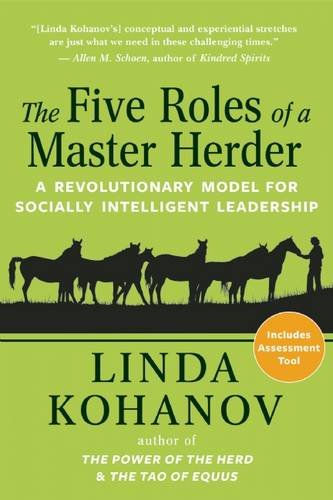 It’s important to realize that this is not a personality test. Roles you overemphasize or avoid may be related to social conditioning, to your job description, or to company culture. Historically, men were taught to wield the Dominant and Predator roles at the expense of the Nurturer/Companion role. Women were encouraged to overemphasize nurturing behavior, and actively discouraged from practicing how to use power effectively. As a result, “the weaker sex” learned how to gain influence through passive aggressive manipulation, as did any male that was treated as a slave or serf. When some women join the workforce, however, they suppress the Nurturer/Companion role and adopt the unbalanced use of the Dominant and Predator roles pioneered by a “masculine,” conquest-oriented approach to power. In both men and women, the Leader and Sentinel roles have been misunderstood, and sometimes devalued.
It’s important to realize that this is not a personality test. Roles you overemphasize or avoid may be related to social conditioning, to your job description, or to company culture. Historically, men were taught to wield the Dominant and Predator roles at the expense of the Nurturer/Companion role. Women were encouraged to overemphasize nurturing behavior, and actively discouraged from practicing how to use power effectively. As a result, “the weaker sex” learned how to gain influence through passive aggressive manipulation, as did any male that was treated as a slave or serf. When some women join the workforce, however, they suppress the Nurturer/Companion role and adopt the unbalanced use of the Dominant and Predator roles pioneered by a “masculine,” conquest-oriented approach to power. In both men and women, the Leader and Sentinel roles have been misunderstood, and sometimes devalued.
As a result of these factors, you’re likely to be innately talented (yet quite possibly undeveloped) in certain roles, and good at other roles because you were trained to be proficient in those areas. For instance, if you work in acquisitions and mergers, you’re likely to score high in the Predator role because your position involves deciding who to lay off (cull). In fields related to social work and mental health, you’re likely to exhibit a high Nurturer/Companion score. If you created the corporation or nonprofit you now work for, you’re more likely to overemphasize the Leader role. Law enforcement and military personnel are more inclined to stress the Dominant and Sentinel roles.
Everyone has been part of a group that has had a “difficult” person in it. How do you use the five roles of a master herder to lead through potentially “explosive” situations, caused by one or more difficult people?
To deal with difficult people effectively, it’s essential first of all to determine which roles certain individuals are overemphasizing. As I mentioned, each of the roles has a shadow side that results in predictable forms of destructive behavior.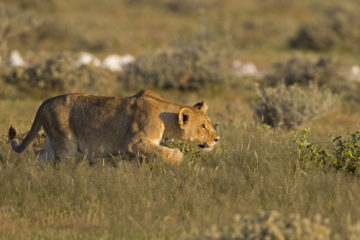
People who over-identify with the Predator role, for instance, tend to use others’ vulnerabilities against them for personal gain. Employees and colleagues can’t admit skill deficiencies, show weakness, or ask for help because of the Predator’s inclination to degrade, fire, or take advantage someone who may simply need additional training to excel. On the upside, someone naturally talented in the Predator role can make tough decisions during lean times. As in nature, they keep life in balance with the available resources. People who overemphasize this role, however, cultivate a more extreme “survival of the fittest, kill or be killed attitude.” At the very worst, they prey on co-workers and the company to achieve self-serving goals, and they can really be quite sneaky about it, like a lion stalking a zebra in high grass.
 Naturally dominant people, on the other hand, are overtly intimidating, and sometimes even abusive. Many exhibit an odd, instinctual inclination to attack others for little or no reason. Dominant horses, cattle, and zebras will engage in this strange form of aggression as well, but in all species these sudden, unprovoked attacks compromise trust, inhibiting teamwork and creativity in human settings. While this behavior seems impulsive to everyone else, it provides a short-term reward that makes sense to overly dominant people and animals: It keeps everyone a bit on edge, causing others to look away or move away when the saucy cow, big bad bull, or flamboyant stallion struts through the herd. Dominants read this as “respect,” and they truly believe that others can be more easily controlled when herd members are kept off balance. Overly dominant humans also express a “my way or the highway” attitude that can be especially problematic in the 21st century: Talented, independent people are more than happy to “hit the road” in these situations, especially when the Internet makes it easier to work from home and start a business online.
Naturally dominant people, on the other hand, are overtly intimidating, and sometimes even abusive. Many exhibit an odd, instinctual inclination to attack others for little or no reason. Dominant horses, cattle, and zebras will engage in this strange form of aggression as well, but in all species these sudden, unprovoked attacks compromise trust, inhibiting teamwork and creativity in human settings. While this behavior seems impulsive to everyone else, it provides a short-term reward that makes sense to overly dominant people and animals: It keeps everyone a bit on edge, causing others to look away or move away when the saucy cow, big bad bull, or flamboyant stallion struts through the herd. Dominants read this as “respect,” and they truly believe that others can be more easily controlled when herd members are kept off balance. Overly dominant humans also express a “my way or the highway” attitude that can be especially problematic in the 21st century: Talented, independent people are more than happy to “hit the road” in these situations, especially when the Internet makes it easier to work from home and start a business online.
In a crisis, immature Dominants increase panic and decrease thoughtful problem solving abilities. It’s difficult for them to lead anyone anywhere in novel situations. As a result, they often don’t function well in innovative settings, and sometimes vehemently resist change because reinforcing the status quo offers them more control.
But just as nature relies on predators to keep life in balance, the Dominant role is useful when employed as a tool. Mature, well-balanced animals use dominance to break up fights between herd members, drive off predators, and drive herd members away from danger or toward a goal. Master Herder-style leaders use the Dominant role to moderate unproductive behavior in groups, direct people toward common goals, and get lazy or resistant employees back on track. Large herbivores like horses, wildebeests and Cape Buffalo use collective dominance to drive off lions.
Those gifted in the Leader role, on the other hand, are attracted to novel situations. They tend to be innovative, inspirational, and charismatic. But they also show predictable dysfunctions when lacking proficiency in the other roles. Visionary Leaders in particular tend to get too far out in front of others and become impatient with people who need more information or training to catch up, especially if these Leaders lack Nurturer/Companion-related skills. If Leaders lack the assertiveness associated with the Dominant role, they tend to become workaholics, because in their words: “it’s easier to do it myself.” They can also seem aloof and self-absorbed, especially when hyper-focused on the mission or goal.
 Those gifted in Nurturer/Companion skills are great at making connections and gaining loyalty. They aren’t overtly aggressive. But they can create an incredibly toxic work environment when they lack the skills associated with the other roles. As masters of passive aggressive manipulation, these people act our anger and frustration in secretive yet increasingly virulent ways, making it hard for supervisors to catch difficulties in their earliest, most manageable stages. If Nurturer/Companions feel wronged in some way, they don’t address the issue directly. They hold grudges, gossip, and undermine people behind their backs. Eventually, they’ll pretty much refuse to communicate with the perceived offender, which can become quite a problem. Simply by giving one another the silent treatment, key staff members can make it hard for others to get their jobs done. Over time, factions are created with each side feeling undermined by the others.
Those gifted in Nurturer/Companion skills are great at making connections and gaining loyalty. They aren’t overtly aggressive. But they can create an incredibly toxic work environment when they lack the skills associated with the other roles. As masters of passive aggressive manipulation, these people act our anger and frustration in secretive yet increasingly virulent ways, making it hard for supervisors to catch difficulties in their earliest, most manageable stages. If Nurturer/Companions feel wronged in some way, they don’t address the issue directly. They hold grudges, gossip, and undermine people behind their backs. Eventually, they’ll pretty much refuse to communicate with the perceived offender, which can become quite a problem. Simply by giving one another the silent treatment, key staff members can make it hard for others to get their jobs done. Over time, factions are created with each side feeling undermined by the others.
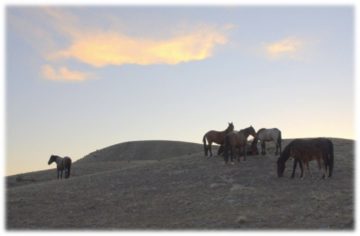
Sentinels keenly observe social, procedural, and inter-departmental dynamics in relation to how the organization interacts with the environment, culture, and economy. But people who over-identity with this role can become exceedingly aloof and detached, mostly because they have to stand apart from the group to gain that perspective. When lacking in leadership and dominance skills, they can become hyper-vigilant and problem-focused without offering solutions or helping to intervene in conflict or create new policies and procedures. If you offend or devalue such a person, he or she is likely to withhold information and watch you struggle as a result, sometimes swooping in to benefit from your subsequent failure.
It’s important to realize that in most situations, a person acting out in any of these ways is not defective or innately ruthless; he or she is overemphasizing a role. A supervisor who employs the Master Herder model can take several steps to help “difficult” people replace dysfunctional behaviors with more productive responses to various challenges. In this effort, a manager or executive coach will help individuals:
- Recognize the benefits of the role they are overemphasizing, and, perhaps more importantly, learn when and how to use these benefits consciously.
- Recognize the challenges and dysfunctional behaviors that arise from overemphasizing the role.
- Learn when and how to employ the strengths of the other roles to replace the dysfunctional behavior.
The book outlines the benefits and challenges of each role and offers case studies of how to recognize and utilize all five roles in the modern tribes of your workplace, family, and other social organizations. A balanced use of the Five Roles is also incredibly effective in working with difficult horses, which is how I learned these skills to begin with, as I describe in the book.
 How would you sum up the importance of this model in leading change professionally and culturally?
How would you sum up the importance of this model in leading change professionally and culturally?
The Five Roles of a Master Herder helps you make sense of previously confusing group dynamics, while helping people to develop a mature, balanced, mutually empowering approach to leadership and life. This ancient yet surprisingly innovative model helps us navigate change, handle conflict, and support innovation that serves the individual as well as the group, and perhaps most importantly, the health and well being of all species and countless generations to come.
What more could we possibly ask for in this time of unprecedented, potentially dangerous, mind-bending possibility?
What kinds of workshops will you offer this year to help people develop all five roles?
I will be doing two types of workshops: There are the multi-day, equine-facilitated workshops where people practice the various roles with horses through safe yet still profound—and fun—ground activities. The nature of these workshops makes it necessary to limit them to 8 to 12 people. Because of the facilities and the kinds of expert horse teachers we need for these trainings, fully experiential workshops reflect those costs, but working with horses to learn the five roles is incredibly effective. Once you can set boundaries with a thousand pound animal, gain his trust, direct him to perform a certain goal, and entice him to follow you willingly with no restraints, using these same roles with a 200-pound boss, employee, or family member is suddenly no big deal.
But not everyone has the time or inclination to head out to the barn, at least not at first. Over the years, I’ve also developed powerful indoor workshops for larger groups of people. These seminars allow me to introduce the tools and concepts from The Five Roles of a Master Herder at a much lower cost than a full-blown equine-facilitated workshop. Participants will get to take the Master Herder Professional Assessment and receive coaching in how to interpret the results. We will also learn how to balance the roles in our personal as well as professional lives. And we’ll learn some innovative skills for handling conflict and for motivating and empowering others.
A number of businesses have brought my colleagues and me in to do these workshops for their staff on site, including Nike, Chubb Insurance, the Bensman Group, a number of credit unions and financial institutions, and a nationally recognized animal rescue organization.
I’m pleased to be able to open such workshops up to a wider public when I go on tour. I will be announcing some events in Virginia Beach, Utah, Western Canada, and Los Angeles as soon as the details are firmed up.
In the meantime, dates are confirmed for June and July. I will be doing the one-day indoor workshop in Buffalo, NY in June http://eponaquest.com/workshop/5-roles-ny/ and in Sebastapol, CA (near San Francisco) in July http://eponaquest.com/workshop/5-roles-california-2/ . I will be doing multi-day equine-facilitated workshops in Sebastapol in July and at my home based in Arizona in October http://eponaquest.com/workshop/power-herd-working-eponaquests-horses-master-five-roles/ .
If you happen to live in the Dallas, Texas area, I will be doing the one-day workshop this Thursday, May 26 as part of The Healing with Horse Collective conference. Then on Friday, May 27, I will offer a keynote on the transformational power of the human-animal bond. Saturday I will demonstrate the Eponaquest approach to equine-facilitated learning. Other leaders in the field will be joining us. There are still spaces available. For more information and to register:
http://www.healingwithhorse.org/symposium-registration/
When is the book itself available?
The book is hot off the press as we speak. I have a copy in hand that was Fed X’d to me last week. I’m very pleased with how it turned out. It should be arriving in stores in the next two weeks. You can also preorder it on Amazon.com (link to the Master Herder page on Amazon) in hardcover, Kindle and audiobook formats, and it will be landing on your doorstep soon.